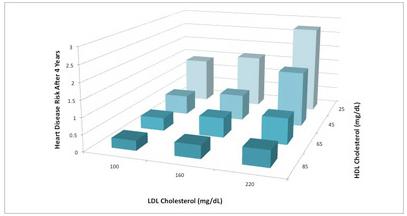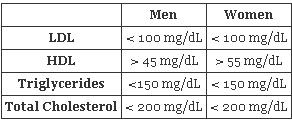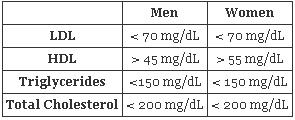Cholesterol 101
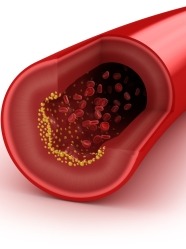
by mark yarchoan and jessica swienckowski
This article was updated in 2021 – click here to read the new version.
From day to day, through all the finger sticks, CGM trends, and carb counting, we here at diaTribe often begin to feel a little “glucocentric”: too focused on blood sugar levels, possibly at the expense of the “bigger picture” of diabetes. But the truth is, the most common cause of death for people with diabetes is heart disease – calling our attention to other health markers such as cholesterol.
Diabetic patients are at higher risk for heart disease for many reasons, but one is that diabetes and insulin resistance are associated with abnormal cholesterol levels. Therefore, good glucose control and good lipid control should go hand in hand (of course, the “B” of the “ABCs” – blood pressure – can’t go ignored! Stay tuned as diaTribe tackles blood pressure next in issue #19).
The diabetes community has long been working toward a more holistic “lipocentric” view of the disease, focused on both glucose and cholesterol care. Thus, we thought we would take the opportunity to dive into this issue a little further, especially given that Kelly’s been given some very specific advice on cholesterol recently.
This Learning Curve will take you beyond the slips at doctor’s offices to explain why cholesterol levels are so important, especially for people with diabetes, and how you can take control of your cholesterol.
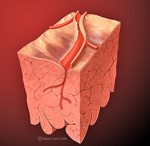
Excess amounts of certain kinds of cholesterol can lead to heart disease by promoting atherosclerosis (the build up of plaque in your arteries).
Illustration courtesy of Patrick J. Lynch
cholesterol 101
Cholesterol is a fat-like substance that is essential for your body in controlled amounts. Your body makes its own cholesterol, but you also absorb cholesterol from your diet. Excess amounts of certain kinds of cholesterol can lead to heart disease by promoting atherosclerosis (or the build up of plaque in your arteries). In turn, atherosclerosis can put you at a higher risk for heart attack or stroke. While cholesterol levels are in part determined by genetics, we can improve our cholesterol health through diet and exercise.
Adults should have their cholesterol levels checked every five years. There are four types of cholesterol or fat that should be measured: Low-density lipoprotein (LDL), high-density lipoprotein (HDL), triglycerides, and total cholesterol.
LDL is often called the “bad” cholesterol because it can build up in the arteries, forming plaques that can lead to heart disease and stroke.
HDL is the “good” cholesterol that may protect against heart disease. It is believed to promote the removal of bad cholesterol from the arteries.
Like LDL cholesterol, triglycerides can increase the risk of a number of conditions including heart disease and diabetes.
Total cholesterol (calculated as Total Cholesterol = HDL + LDL + Triglycerides/5) provides a “big picture” look of your risk for heart disease, though its individual components need to be considered.
Figure 1: Both LDL and HDL cholesterol are important factors in heart disease. To lower your risk, it is best to have low LDL cholesterol (<100 mg/dL) and high HDL cholesterol (>45 mg/dL). A person with an LDL of over 220 mg/dL and an HDL of less than 25 mg/dL has about ten times the risk of developing heart disease as a person with an LDL of less than 100 mg/dL and an HDL of greater than 85 mg/dL. Figured adapted with permission from Dr. Daniel Rader (University of Pennsylvania Medical School); data from Am J Med 1977;62:707-714.
Below are the most recent guidelines for cholesterol, taken from the American Diabetes Association (ADA) website:
While these are the current national guidelines, many physicians are beginning to recommend even lower levels of LDL for “high-risk” patients—including those with diabetes. We recently attended a Bridges to Better Medicine discussion at Rockefeller University featuring Drs. Jan Breslow and Andy Plump, who mentioned guidelines are expected to be revised in the near future.
Some experts, including several diaTribe advisory board members, suggest that an LDL cholesterol level of less than 70 mg/dL may be ideal for people with diabetes, and the US National Institutes of Health Adult Treatment Panel that is responsible for setting cholesterol guidelines is currently evaluating whether tougher recommendations are warranted. Dr. Nancy Bohannon and other diaTribe advisory board members including Dr. Satish Garg of the Barbara Davis Center for Childhood Diabetes in Denver, follow “stricter” cholesterol guidelines for people with diabetes such as the panel below.
It is a good idea to know your cholesterol level regardless of where you stand and to track it over time, just as you may already track your A1c. It can be very rewarding to watch your LDL and triglycerides fall and your HDL rise when you start making healthy changes in your life.
how to lower ldl cholesterol
The best way to lower LDL cholesterol is to avoid eating foods containing high levels of saturated fat (e.g., bacon, sausage, coconut, egg yolks, and whole-milk products) and dangerous trans fats (e.g., margarine, ramen soup cups, fried foods, and certain cookies/candy), and to eat foods rich in soluble fiber (e,g., whole grains, oatmeal, beans, and fruits).
Some medications including statins (also known as HMG CoA reductase inhibitors) may lower your LDL cholesterol. These drugs work by blocking your liver from making too much cholesterol. Recent large-scale clinical trials including the MRC/BHF Heart Protection Study suggest that using statins to lower LDL cholesterol even more in patients already meeting national targets can be beneficial to cardiovascular health. Other LDL lowering drugs including ezetimibe (Zetia®) and resins (also known as bile acid sequestrant or bile acid-binding resins) block the absorption of cholesterol from the diet. There is very good evidence that statins lower the risk of heart problems, but evidence supporting the use of other LDL lowering drugs is not as clear.
how to heighten hdl cholesterol
Smoking, obesity, diabetes (especially type 2 diabetes), and having a sedentary lifestyle can all lower the good HDL cholesterol. HDL cholesterol is often better in type 1 diabetes and there are some data suggesting that HDL cholesterol may not correlate as well with cardiovascular disease for people with type 1 diabetes, though they are still at greater risk than people without diabetes.
To raise HDL cholesterol, the first steps are to avoid tobacco smoke, lose weight, improve glucose control, and try to get an hour of physical activity every day. Consuming alcohol in moderation (1-2 servings a day), and eating foods high in omega 3 fatty acids such as fish oil, walnuts, and flax seed can also raise HDL cholesterol levels.
Several drugs including fibrates (fibric acid derivatives) and niacin (nicotinic acid) may also raise your HDL cholesterol. However, niacin is used very cautiously in people with diabetes because it raises insulin resistance, making glucose control more difficult. There is currently a very large clinical trial called the ACCORD (Action to Control Cardiovascular Risk in Diabetes) trial that is studying whether the use of fibrates can reduce the risk of heart problems in people with diabetes. The 10,000 participant study is sponsored by the National Heart, Lung, and Blood Institute (NHLBI) of the National Institutes of Health (NIH), and primary results are expected next year.
diaTribe editor Kelly Close was recently advised by her endocrinologist, Dr. Nancy Bohannon of St. Luke's Hospital in San Francisco, to go on a statin. Though her cholesterol is already less than 100 mg/dl, recent evidence suggests that even lower LDL cholesterol can benefit patients with an elevated risk of cardiovascular disease, regardless of current cholesterol levels. You should consult your endocrinologist to discuss your cholesterol goals if this topic is not already a regular part of your diabetes management. Stay tuned for our next issue where we will discuss our n=1 trial of Kelly starting a statin.

